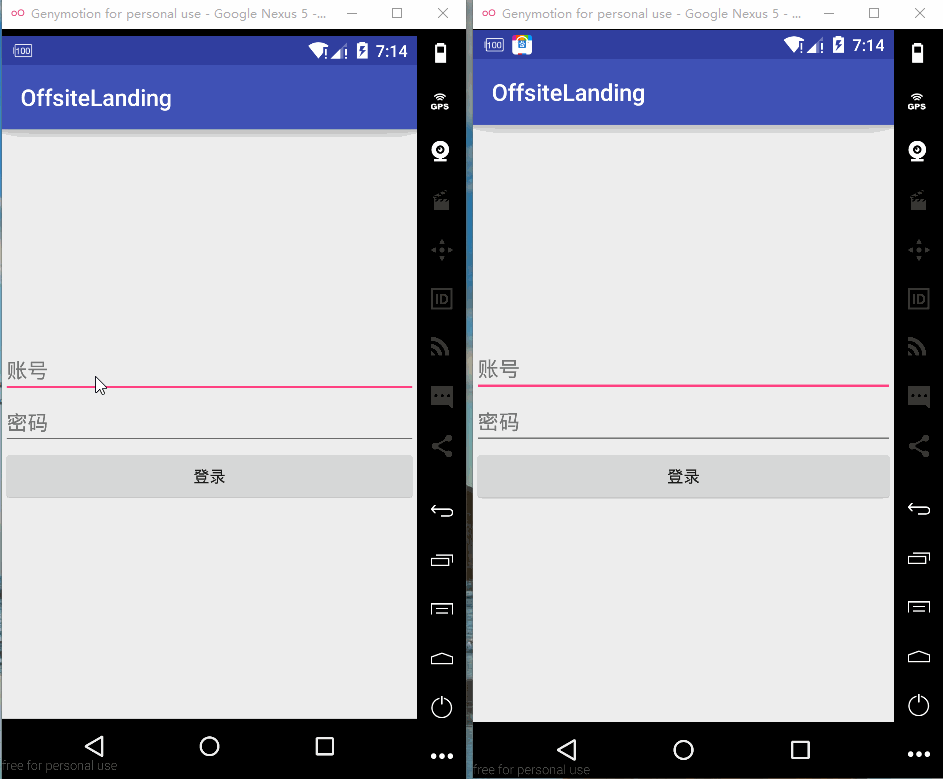Android利用Jpush实现异地登陆下线
一、说明
- 客户端程序中使用了xUtils框架(进行UI,资源的绑定,以及访问网络)
- JPush客户端集成可参照:http://docs.jiguang.cn/jpush/client/Android/android_guide/
- JPush服务器端集成参照:http://docs.jiguang.cn/jpush/server/3rd/java_sdk/
- xUtils下载及使用:https://github.com/wyouflf/xUtils3
二、客户端
2.1 添加依赖
compile 'cn.jiguang:jpush:2.1.8'
compile 'org.xutils:xutils:3.3.36'2.2 创建MyApplication,初始化jpush以及xutils
MyApplication.java
package com.gcy.offsitelanding.offsitelanding;
import android.app.Application;
import org.xutils.x;
import cn.jpush.android.api.JPushInterface;
/**
* Created by gcy71 on 2016/10/9.
*/
public class MyApplication extends Application {
@Override
public void onCreate() {
super.onCreate();
JPushInterface.setDebugMode(true);
JPushInterface.init(this);
/*xUtils 初始化*/
x.Ext.init(this);
x.Ext.setDebug(BuildConfig.DEBUG);
}
}
MyApplication.java写完后,还需将其在AndroidManifest.xml中配置,直接在application尖括号里添加如下代码:
android:name=".MyApplication"2.3 创建自定义Receiver
客户端向服务器端发起登录请求后,服务器端若发现该账号已处于登录状态时,服务器会向当前账户在线的终端推送一条自定义消息,如果没有自定义Receiver的话,客户端将不会对该自定义消息进行处理。
JpushReceiver.java
package com.gcy.offsitelanding.offsitelanding;
import android.app.NotificationManager;
import android.content.BroadcastReceiver;
import android.content.Context;
import android.content.Intent;
import android.os.Bundle;
import android.util.Log;
import cn.jpush.android.api.JPushInterface;
public class JpushReceiver extends BroadcastReceiver {
private NotificationManager nm;
@Override
public void onReceive(Context context, Intent intent) {
if (null == nm) {
nm = (NotificationManager) context.getSystemService(Context.NOTIFICATION_SERVICE);
}
Bundle bundle = intent.getExtras();
// Log.d(TAG, "onReceive - " + intent.getAction() + ", extras: " + AndroidUtil.printBundle(bundle));
if (JPushInterface.ACTION_REGISTRATION_ID.equals(intent.getAction())) {
//Log.d(TAG, "JPush用户注册成功");
} else if (JPushInterface.ACTION_MESSAGE_RECEIVED.equals(intent.getAction())) {
Log.d("jpush" , bundle.getString(JPushInterface.EXTRA_MESSAGE) + "自定义消息");
Intent mIntent = new Intent(context, MainActivity.class);
//mIntent.putExtra("intentType", 0);
mIntent.putExtra("MessageContent",bundle.getString(JPushInterface.EXTRA_MESSAGE));
mIntent.setFlags(Intent.FLAG_ACTIVITY_NEW_TASK);
context.startActivity(mIntent);
} else if (JPushInterface.ACTION_NOTIFICATION_RECEIVED.equals(intent.getAction())) {
//Log.d(TAG, "接受到推送下来的通知");
} else if (JPushInterface.ACTION_NOTIFICATION_OPENED.equals(intent.getAction())) {
//Log.d(TAG, "用户点击打开了通知");
} else {
//Log.d(TAG, "Unhandled intent - " + intent.getAction());
}
}
}JpushReceiver书写完毕后,我们仍需在AndroidManifest.xml中配置该Recevier
<receiver
android:name="com.gcy.offsitelanding.offsitelanding.JpushReceiver"
android:enabled="true">
<intent-filter>
<action android:name="cn.jpush.android.intent.REGISTRATION" />
<action android:name="cn.jpush.android.intent.UNREGISTRATION" />
<action android:name="cn.jpush.android.intent.MESSAGE_RECEIVED" />
<action android:name="cn.jpush.android.intent.NOTIFICATION_RECEIVED" />
<action android:name="cn.jpush.android.intent.NOTIFICATION_OPENED" />
<action android:name="cn.jpush.android.intent.ACTION_RICHPUSH_CALLBACK" />
<action android:name="cn.jpush.android.intent.CONNECTION" />
<category android:name="您的程序包名" />
intent-filter>
receiver>2.4 布局文件以及MainActivity代码
activity_main.xml
<LinearLayout xmlns:android="http://schemas.android.com/apk/res/android"
android:id="@+id/activity_main"
android:layout_width="match_parent"
android:layout_height="match_parent"
android:orientation="vertical"
android:gravity="center">
<EditText
android:layout_width="match_parent"
android:layout_height="wrap_content"
android:hint="账号"
android:id="@+id/login_username"/>
<EditText
android:layout_width="match_parent"
android:layout_height="wrap_content"
android:hint="密码"
android:id="@+id/login_pwd"/>
<Button
android:layout_width="match_parent"
android:layout_height="wrap_content"
android:text="登录"
android:id="@+id/login" />
LinearLayout>
MainActivity.java
package com.gcy.offsitelanding.offsitelanding;
import android.content.ContentValues;
import android.content.DialogInterface;
import android.os.AsyncTask;
import android.support.v7.app.AlertDialog;
import android.support.v7.app.AppCompatActivity;
import android.os.Bundle;
import android.view.View;
import android.widget.Button;
import android.widget.EditText;
import android.widget.Toast;
import org.xutils.common.Callback;
import org.xutils.http.RequestParams;
import org.xutils.view.annotation.ViewInject;
import org.xutils.x;
import java.net.HttpURLConnection;
import java.util.ArrayList;
import java.util.List;
import cn.jpush.android.api.JPushInterface;
public class MainActivity extends AppCompatActivity {
String url = "http://169.254.97.133:8080/offsitelanding_server/LoginServlet";
/**
* @ViewInject注解
* xUtils使用注解方式就可以进行UI,资源的绑定,替代findViewById()
*/
@ViewInject(R.id.login_username)
private EditText loginUserName;
@ViewInject(R.id.login_pwd)
private EditText loginPwd;
@ViewInject(R.id.login)
private Button loginBtn;
@Override
protected void onCreate(Bundle savedInstanceState) {
super.onCreate(savedInstanceState);
setContentView(R.layout.activity_main);
x.view().inject(this);
init();
}
public void init(){
loginBtn.setOnClickListener(new View.OnClickListener() {
@Override
public void onClick(View v) {
//利用xUtils访问网络(post请求)
RequestParams params = new RequestParams(url);
params.addParameter("username" , loginUserName.getText().toString());
params.addParameter("password" , loginPwd.getText().toString());
params.addParameter("registrationId" , JPushInterface.getRegistrationID(MainActivity.this));
x.http().post(params, new Callback.CommonCallback() {
@Override
public void onSuccess(String result) {
Toast.makeText(MainActivity.this , "登录成功" , Toast.LENGTH_LONG).show();
}
@Override
public void onError(Throwable ex, boolean isOnCallback) {
Toast.makeText(MainActivity.this , "登陆失败" , Toast.LENGTH_LONG).show();
}
@Override
public void onCancelled(CancelledException cex) {
}
@Override
public void onFinished() {
}
});
}
});
//利用Intent判断是否有自定义消息
String message = getIntent().getStringExtra("MessageContent");
if(message != null && !message.equals("")){
//如果有,则弹出对话框,提示用户下线
new AlertDialog.Builder(this).setTitle("系统提示").setMessage(message).setPositiveButton("确定", new DialogInterface.OnClickListener() {
@Override
public void onClick(DialogInterface dialog, int which) {
//在这里可清除本地的用户信息
}
}).setNegativeButton("重新登录", new DialogInterface.OnClickListener() {
@Override
public void onClick(DialogInterface dialog, int which) {
//再次执行登录操作
}
}).show();
}
}
}
三、服务器端
3.1 说明
- 首先创建一个Dynamic Web project。
- 服务器器端集成jpush需要注意依赖包:gosn、log4j、slf4j,本例的服务器端程序为使用的是servlet实现。
- 本例未使用数据库,采用一个集合(users)来存储用户信息。
- 本例的实体类User(username : 用户名 , password : 密码 , status : 在线状态 , registrationId : 用户在线的设备ID(指在Jpush上注册的ID))。
3.2 处理逻辑
- Servlet接收客户端传来的参数(username , password , registrationId)。
- Servlet判断是否存在该用户,若存在跳转到3,若不存在,返回用户不存在
- 判断用户输入的密码是否正确,若不正确返回密码错误,若正确跳转到4
- 判断当前用户是否处于在线状态,若不在线,执行登陆操作添加在线终端ID,若在线,则通知下线,并执行登录操作,修改用户在线终端ID。
3.3 LoginServlet的编写
LoginServlet.java
package com.gcy.offsitelanding_server;
import java.io.IOException;
import java.io.PrintWriter;
import java.util.ArrayList;
import java.util.List;
import javax.servlet.ServletException;
import javax.servlet.annotation.WebServlet;
import javax.servlet.http.HttpServlet;
import javax.servlet.http.HttpServletRequest;
import javax.servlet.http.HttpServletResponse;
import cn.jiguang.common.resp.APIConnectionException;
import cn.jiguang.common.resp.APIRequestException;
import cn.jpush.api.JPushClient;
import cn.jpush.api.push.model.Message;
import cn.jpush.api.push.model.Platform;
import cn.jpush.api.push.model.PushPayload;
import cn.jpush.api.push.model.audience.Audience;
@WebServlet("/LoginServlet")
public class LoginServlet extends HttpServlet {
private static final long serialVersionUID = 1L;
private List users = new ArrayList();
public LoginServlet() {
super();
users.add(new User("user01", "123456", 0));
users.add(new User("user02", "123456", 0));
users.add(new User("user03", "123456", 0));
}
protected void doGet(HttpServletRequest request, HttpServletResponse response) throws ServletException, IOException {
response.getWriter().append("Served at: ").append(request.getContextPath());
}
protected void doPost(HttpServletRequest request, HttpServletResponse response) throws ServletException, IOException {
doGet(request, response);
response.setContentType("text/html");
response.setCharacterEncoding("UTF-8");
PrintWriter out = response.getWriter();
String username = request.getParameter("username");
String password = request.getParameter("password");
String registrationId = request.getParameter("registrationId");
User user = findUserByName(username);
if(user == null){
out.println("The current user does not exist");
}else{
if(user.getPassword().equals(password)){
//登录成功,若当前用户在其他地方登录,应向其推送消息并将其下线
if(user.getStatus() == 1){
//这里注意:两个字符串前面是masterSecret , 后面是appKey
JPushClient jPushClient = new JPushClient("0bdecb00531ec118a7b982db", "f9ad20faed32beed296a71bd");
PushPayload payload = PushPayload.newBuilder().setPlatform(Platform.all()).setAudience(Audience.registrationId(user.getRegistrationId()))
.setMessage(Message.newBuilder().setMsgContent("你的账号在另一台手机上登陆,请确认你的账号和密码是否泄露!!").build()).build();
try {
jPushClient.sendPush(payload);
} catch (APIConnectionException | APIRequestException e) {
e.printStackTrace();
}
}else{
user.setStatus(1);
}
user.setRegistrationId(registrationId);
System.out.println(registrationId);
out.print("success");
}else{
out.println("Account and password do not match");
}
}
}
public User findUserByName(String userName){
for(User u : users){
if(u.getUsername().equals(userName)){
return u;
}
}
return null;
}
}
3.4 实体类User
User.java
package com.gcy.offsitelanding_server;
public class User {
private String username;
private String password;
private String registrationId;//用户登录的设备(在jpush上的注册ID)
private int status;//登录状态,0-离线 1-在线
public User() {
super();
}
public User(String username, String password, int status) {
super();
this.username = username;
this.password = password;
this.status = status;
}
public String getUsername() {
return username;
}
public void setUsername(String username) {
this.username = username;
}
public String getPassword() {
return password;
}
public void setPassword(String password) {
this.password = password;
}
public int getStatus() {
return status;
}
public void setStatus(int status) {
this.status = status;
}
public String getRegistrationId() {
return registrationId;
}
public void setRegistrationId(String registrationId) {
this.registrationId = registrationId;
}
}
